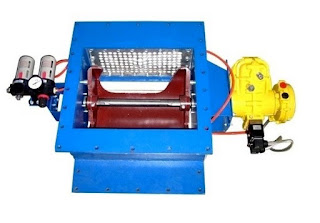 |
| Cement valve using Kinetrol Actuator |
Typically, these raw materials are obtained from open-face quarries, underground mines, or dredging operations. When mining, pockets of pyrite, which significantly increase emissions of sulfur dioxide (SO2), can be found in deposits of limestone, clays, and shales used as raw materials for portland cement.
Transport of the raw materials is accomplished by a variety of mechanisms, including screw
conveyors, belt conveyors, drag conveyors, bucket elevators, air slide conveyors, and pneumatic conveying systems. A variety of valves, gates, and dampers are required to accurately control the flow of raw materials as they are being discharged from pipes, silos, bins and hoppers. These flow control devices all have one thing in common - the actuators that control their opening and closing are exposed to extremely dusty and dirty atmospheres, with significant amounts of vibration - and they are almost always located in an area where repairs are very costly.
Kinetrol vane actuators are used to automate these gate, butterfly and mixer valves because of their ruggedness and their reliability. Additionally, Kinetrol pneumatic actuators have a smaller footprint and consume less air compared to other pneumatic actuators or conventional linear pneumatic cylinders, resulting in significant savings in energy costs.
